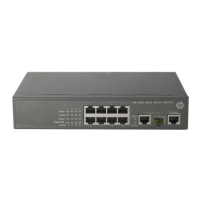Verification
1. The hosts and the server in VLAN 100 can ping one another successfully. The hosts and the server
in VLAN 200 can ping one another successfully. The hosts/server in VLAN 100 cannot ping the
hosts and the server in VLAN 200, and vice versa.
2. Display protocol-based VLAN information on Device to determine whether the configurations have
become valid.
# Display protocol-based VLAN configuration on Device.
[Device-Ethernet1/0/2] display protocol-vlan vlan all
VLAN ID:100
Protocol Index Protocol Type
======================================================
1 ipv4
VLAN ID:200
Protocol Index Protocol Type
======================================================
1 ipv6
# Display protocol-based VLAN information on the ports of Device.
[Device-Ethernet1/0/2] display protocol-vlan interface all
Interface: Ethernet 1/0/1
VLAN ID Protocol Index Protocol Type
======================================================
100 1 ipv4
200 1 ipv6
Interface: Ethernet 1/0/2
VLAN ID Protocol Index Protocol Type
======================================================
100 1 ipv4
200 1 ipv6
Configuration guidelines
Protocol-based VLAN configuration applies only to hybrid ports.
Displaying and maintaining VLAN
To do... Use the command… Remarks
Display VLAN information
display vlan [ vlan-id1 [ to vlan-id2 ] | all |
dynamic | reserved | static ] [ | { begin |
exclude | include } regular-expression ]
Available in any view
Display VLAN interface
information
display interface vlan-interface
[ vlan-interface-id ] [ | { begin | exclude |
include } regular-expression ]
Available in any view
Display hybrid ports or trunk ports
on the device
display port { hybrid | trunk } [ | { begin |
exclude | include } regular-expression ]
Available in any view
Display MAC address-to-VLAN
entries
display mac-vlan { all | dynamic |
mac-address mac-address | static | vlan
vlan-id } [ | { begin | exclude | include }
regular-expression ]
Available in any view
112

